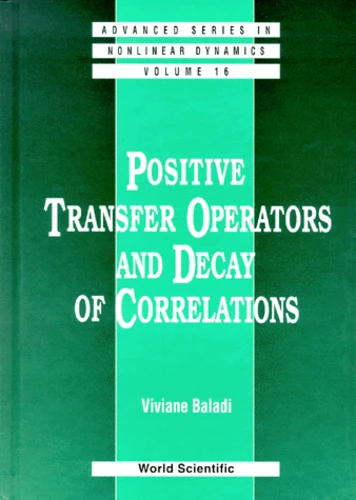Positive Transfer Operators And Decay Of Correlations
Par :Formats :
- Paiement en ligne :
- Livraison à domicile ou en point Mondial Relay estimée à partir du 4 décembreCet article sera commandé chez un fournisseur et vous sera envoyé 10 jours après la date de votre commande.
- Retrait Click and Collect en magasin gratuit
- Livraison à domicile ou en point Mondial Relay estimée à partir du 4 décembre
- Nombre de pages314
- PrésentationRelié
- Poids0.57 kg
- Dimensions16,0 cm × 22,5 cm × 2,2 cm
- ISBN981-02-3328-0
- EAN9789810233280
- Date de parution01/09/2000
- Collectionadvanced series in nonlinear d
- ÉditeurWorld Scientific Publishing
Résumé
Although individual orbits of chaotic dynamical systems are by definition unpredictable, the average behavior of typical trajectories can often be given a precise statistical description. Indeed, there often exist ergodic invariant measures with special additional features. For a given invariant measure, and a class of observables, the correlation functions tell whether (and how fast) the system "mixes", that is, "forgets" its initial conditions. This book, addressed to mathematicians and mathematical (or mathematically inclined) physicists, shows how the powerful technology of transfer operators, imported from statistical physics, has been used recently to construct relevant invariant measures, and to study the speed of decay of their correlation functions, for many chaotic systems. Links with dynamical zeta functions are explained. The book is intended for graduate students or researchers entering the field, and the technical prerequisites have been kept to a minimum.
Although individual orbits of chaotic dynamical systems are by definition unpredictable, the average behavior of typical trajectories can often be given a precise statistical description. Indeed, there often exist ergodic invariant measures with special additional features. For a given invariant measure, and a class of observables, the correlation functions tell whether (and how fast) the system "mixes", that is, "forgets" its initial conditions. This book, addressed to mathematicians and mathematical (or mathematically inclined) physicists, shows how the powerful technology of transfer operators, imported from statistical physics, has been used recently to construct relevant invariant measures, and to study the speed of decay of their correlation functions, for many chaotic systems. Links with dynamical zeta functions are explained. The book is intended for graduate students or researchers entering the field, and the technical prerequisites have been kept to a minimum.

